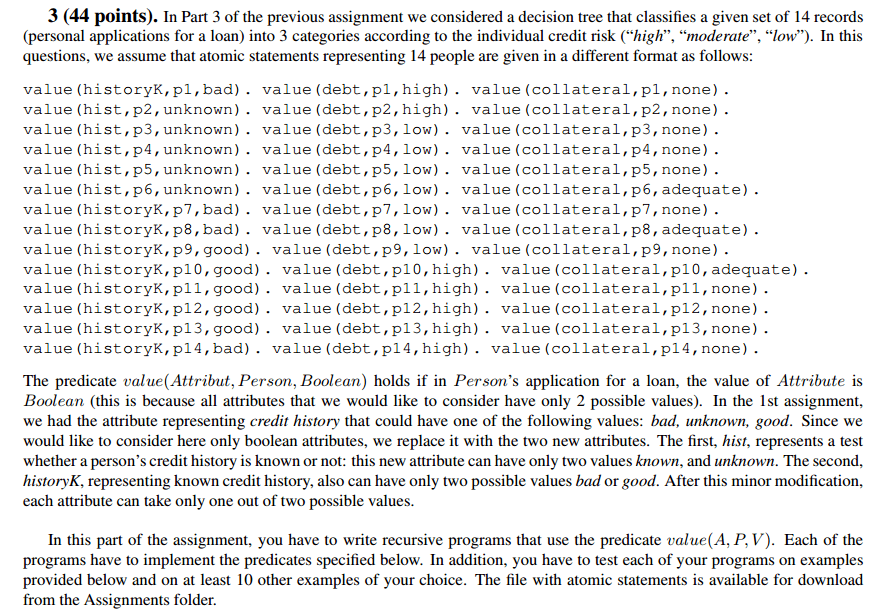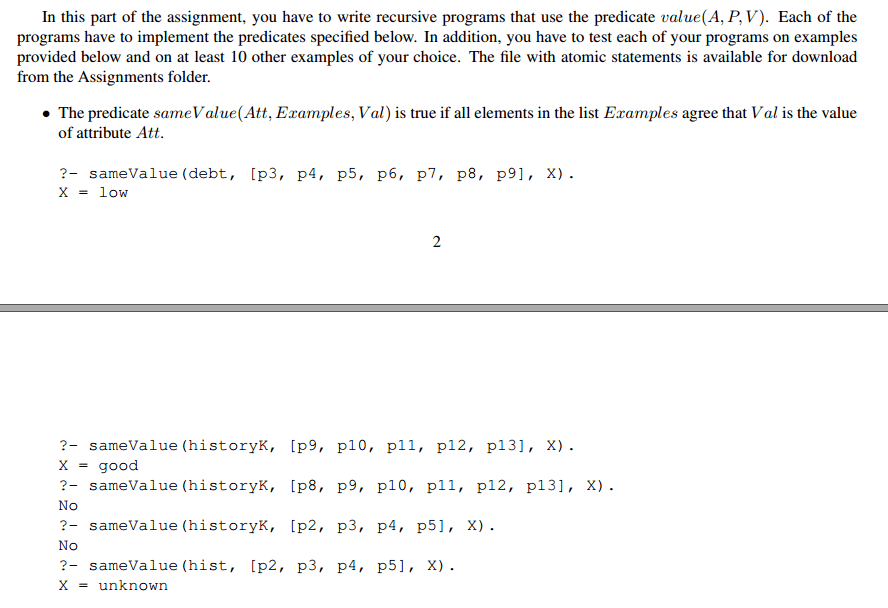Project Description
PROLOG assignment help sample
Assignment info in the image.
Question)
Atomic statements are given. Create a predicate so that all queries are correct (predicate same value, divide, and count).
have to use predicate value(A, P, V).
The name of the predicate, arguments, and variable has to be the same as in the PNG
Most of the student is facing abrupt challenge and difficulty in completing prolog assignment help as most of them are a beginner and it uses a lot of syntaxes.
We help them at standard rates to achieve their goal.
AI, Artificial intelligence terms, Computer abbreviations, Program logic, Programming terms
- Prolog is mainly used for Programming LOGIC. Artificial Intelligence is the main area Prolog is used.
- Prolog has many syntaxes and some shortcuts which need to keep in mind which makes it a declarative language.
For example: While implementing the solution for a given problem, instead of specifying the ways to achieve a certain goal in a specific situation, user needs to specify about the situation (rules and facts) and the goal (query). After these stages, the Prolog interpreter derives the solution. - it does not have much impact on graphical or other algorithms.
Can you get Prolog to compute these answers? 5 + 5 * 10
(5 + 5) * 10
Answers: Type:
X is 5 + 5 * 10.
Prolog responds:
X is 55
 sameValue(_, [], _).
sameValue(_, [], _).
sameValue(Att, [Example|Examples], Val) :-
value(Att, Example, Val),
sameValue(Att, Examples, Val).divide([], _, _, [], []).
divide([Example|Examples], Att, Boolean, [P|Pos], Neg) :-
value(Att, Example, Boolean),
P = Example,
divide(Examples, Att, Boolean, Pos, Neg).
divide([Example|Examples], Att, Boolean, Pos, [N|Neg]) :-
value(Att, Example, Val),
Val \= Boolean,
N = Example,
divide(Examples, Att, Boolean, Pos, Neg).
divide([Example|Examples], Att, Boolean, Pos, Neg) :-
not(value(Att, Example, Boolean)),
divide(Examples, Att, Boolean, Pos, Neg).
count([], _, _, 0, 0).
count([Example|Examples], Att, Bool, T, F) :-
value(Att, Example, Bool),
count(Examples, Att, Bool, T1, F),
T is T1 + 1.
count([Example|Examples], Att, Bool, T, F) :-
value(Att, Example, Val),
Val \= Bool,
count(Examples, Att, Bool, T, F1),
F is F1 + 1.
count([Example|Examples], Att, Bool, T, F) :-
not(value(Att, Example, Bool)),
count(Examples, Att, Bool, T, F).
value(historyk, p1, bad).
value(debt, p1, high).
value(collateral, p1, none).
value(hist, p2, unknown).
value(debt, p2, high).
value(collateral, p2, none).
value(hist, p3, unknown).
value(debt, p3, low).
value(collateral, p3, none).
value(hist, p4, unknown).
value(debt, p4, low).
value(collateral, p4, none).
value(hist, p5, unknown).
value(debt, p5, low).
value(collateral, p5, none).
value(hist, p6, unknown).<
value(debt, p6, low).
value(collateral, p6, adequate).
value(historyk, p7, bad).
value(debt, p7, low).
value(collateral, p7, none).
value(historyk, p8, bad).
value(debt, p8, low).
value(collateral, p8, adequate).
value(history, p9, good).
value(debt, p9, low).
value(collateral, p9, none).
value(historyK, p10, good).
value(debt, p10, high).
value(collateral, p10, adequate).
value(history, p11, good).
value(debt, p11, high).
value(collateral, p11, none).
value(historyk, p12, good).
value(debt, p12, high).
value(collateral, p12, none).
value(historyK, p13, good).
value(debt, p13, high).
value(collateral, p13, none).
value(historyk, p14, bad).
value(debt, p14, high).
value(collateral, p14, none).
sameValue(Att, [Example|Examples], Val) :-
value(Att, Example, Val),
sameValue(Att, Examples, Val).
divide([], _, _, [], []).
divide([Example|Examples], Att, Boolean, [P|Pos], Neg) :-
value(Att, Example, Boolean),
P = Example,
divide(Examples, Att, Boolean, Pos, Neg).
divide([Example|Examples], Att, Boolean, Pos, [N|Neg]) :-
value(Att, Example, Val),
Val \= Boolean,
N = Example,
divide(Examples, Att, Boolean, Pos, Neg).
divide([Example|Examples], Att, Boolean, Pos, Neg) :-
not(value(Att, Example, Boolean)),
divide(Examples, Att, Boolean, Pos, Neg).
count([], _, _, 0, 0).
count([Example|Examples], Att, Bool, T, F) :-
value(Att, Example, Bool),
count(Examples, Att, Bool, T1, F),
T is T1 + 1.
count([Example|Examples], Att, Bool, T, F) :-
value(Att, Example, Val),
Val \= Bool,
count(Examples, Att, Bool, T, F1),
F is F1 + 1.
count([Example|Examples], Att, Bool, T, F) :-
not(value(Att, Example, Bool)),
count(Examples, Att, Bool, T, F).
value(historyk, p1, bad).
value(debt, p1, high).
value(collateral, p1, none).
value(hist, p2, unknown).
value(debt, p2, high).
value(collateral, p2, none).
value(hist, p3, unknown).
value(debt, p3, low).
value(collateral, p3, none).
value(hist, p4, unknown).
value(debt, p4, low).
value(collateral, p4, none).
value(hist, p5, unknown).
value(debt, p5, low).
value(collateral, p5, none).
value(hist, p6, unknown).<
value(debt, p6, low).
value(collateral, p6, adequate).
value(historyk, p7, bad).
value(debt, p7, low).
value(collateral, p7, none).
value(historyk, p8, bad).
value(debt, p8, low).
value(collateral, p8, adequate).
value(history, p9, good).
value(debt, p9, low).
value(collateral, p9, none).
value(historyK, p10, good).
value(debt, p10, high).
value(collateral, p10, adequate).
value(history, p11, good).
value(debt, p11, high).
value(collateral, p11, none).
value(historyk, p12, good).
value(debt, p12, high).
value(collateral, p12, none).
value(historyK, p13, good).
value(debt, p13, high).
value(collateral, p13, none).
value(historyk, p14, bad).
value(debt, p14, high).
value(collateral, p14, none).
We are expert in Prolog Programming and all its syntax from beginner to higher level. We helped a lot of students for all their Prolog Programming languages and all types of functional programming languages like LISP, Dr SCHEME, RACKET and others
UPLOAD your requirement with confidence and get your task done as early as possible
Project Details
- Date October 26, 2020
- Tags Prolog and Clisp



Comments are closed.